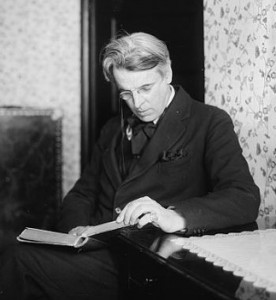 When I took my “Literature in the 20th Century” course at my university, the professor of the class called William Butler Yeats’s “The Lake Isle of Innisfree” one of the most beautiful poems she had ever read; an article I stumbled upon recently includes Yeats in the “The 10 Greatest Poets.” Clearly W.B. Yeats has a powerful effect on people, and “Innisfree” in particular: it’s easily one of his most well-known works. The poem’s rhythmic sway and vivid imagery make it an incredibly enjoyable read, and it sends out a beautiful message—that we should enjoy life, even though we know that death is inevitable:
When I took my “Literature in the 20th Century” course at my university, the professor of the class called William Butler Yeats’s “The Lake Isle of Innisfree” one of the most beautiful poems she had ever read; an article I stumbled upon recently includes Yeats in the “The 10 Greatest Poets.” Clearly W.B. Yeats has a powerful effect on people, and “Innisfree” in particular: it’s easily one of his most well-known works. The poem’s rhythmic sway and vivid imagery make it an incredibly enjoyable read, and it sends out a beautiful message—that we should enjoy life, even though we know that death is inevitable:
I will arise and go now, and go to Innisfree,
And a small cabin build there, of clay and wattles made:
Nine bean-rows will I have there, a hive for the honey-bee;
And live alone in the bee-loud glade.
And I shall have some peace there, for peace comes dropping slow,
Dropping from the veils of the morning to where the cricket sings;
There midnight’s all a glimmer, and noon a purple glow,
And evening full of the linnet’s wings.
I will arise and go now, for always night and day
I hear lake water lapping with low sounds by the shore;
While I stand on the roadway, or on the pavements grey,
I hear it in the deep heart’s core.
The opening stanza is reminiscent of Henry David Thoreau’s Walden; images of “a small cabin” (2) built from scratch and “nine bean-rows” (3), all while the narrator is living in solitude, call to mind Thoreau’s concept of “living deliberately.” The narrator certainly sees the benefits of this lifestyle, as he predicts “peace there” (5). Even in this tranquil space, peaces comes “slow[ly]” (5), which illuminates how distracting and stressful urban places are for us. Therefore, we must do whatever we can to find peace and relaxation, to really relish our lives while we can. Yeats’s expressive descriptions of the times of day really add to the notion that life is beautiful.
In the final lines, the narrator emphasizes how he is constantly reminded of death’s imminence. The repetition of the “lake water lapping” (10), and at all times, “always night and day” (9), shows just how prominent the thought is in the narrator’s mind. No matter where he is, be it “on the roadway, or on the pavements grey” (11), the idea stays with him. In his mind it may be just a subtle acknowledgment, but “in the deep heart’s core” (12), it is the recognition of a universal event in life, one that unites all of us. Even if we must go, however, it doesn’t mean we have to spend our lives dreading it. Life is meant to be enjoyed, and whether we find this joy out in the wild or in the bustle of a large city, we should learn to cherish it.
For work by another Nobel Prize-winning Irish poet, see this post on Seamus Heaney.

 “The Lake Isle of Innisfree” by William Butler Yeats
“The Lake Isle of Innisfree” by William Butler Yeats



 “Songbird” by Fleetwood Mac
“Songbird” by Fleetwood Mac
 First the Wealth Gap, Now the U.S. Has a Growing Health Gap
First the Wealth Gap, Now the U.S. Has a Growing Health Gap
 How to Comfort A Dying Loved One
How to Comfort A Dying Loved One














